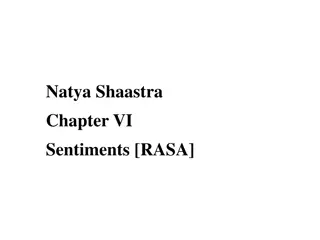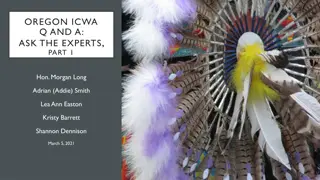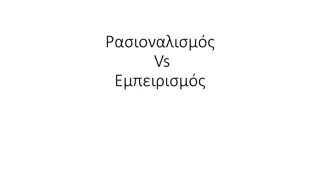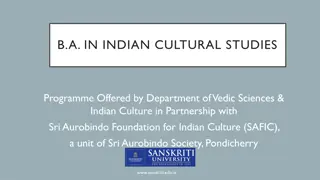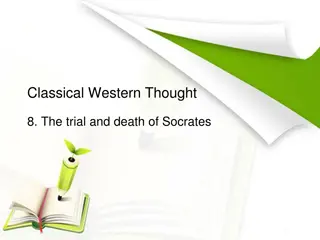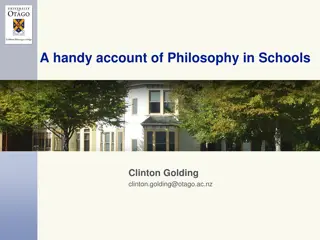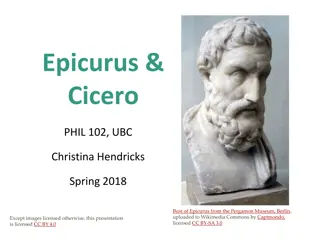Ancient Indian Philosophical Tradition
This content delves into the rich philosophical heritage of ancient India, highlighting the reverence for flora and fauna evident in mythological tales, religious practices, and poetic expressions. It discusses the transition from theocentric to humanistic worldviews, emphasizing the importance of eco-centrism and dignity for all living beings. Through examples like Vishnu's avatars, cow worship, Jain practices, and poetic verses, it showcases a holistic approach to life that celebrates interconnectedness and unity with nature.
Download Presentation

Please find below an Image/Link to download the presentation.
The content on the website is provided AS IS for your information and personal use only. It may not be sold, licensed, or shared on other websites without obtaining consent from the author.If you encounter any issues during the download, it is possible that the publisher has removed the file from their server.
You are allowed to download the files provided on this website for personal or commercial use, subject to the condition that they are used lawfully. All files are the property of their respective owners.
The content on the website is provided AS IS for your information and personal use only. It may not be sold, licensed, or shared on other websites without obtaining consent from the author.
E N D
Presentation Transcript
--- D.Raja Ganesan Ph.D Former Professor University of Madras
Living in Harmony with Flora and Fauna -a scene from the Sanskrit epic Sakunthlam
European Renaissance European Renaissance made for a transition from a theocentric worldview to a, yes, humanistic worldview. Humanism is but phylogenetic egocentrism The challenge before us is to make it Ecocentric i.e., encompass our flora and fauna
Ancient Indian Philosophical Traditions Are a promising source of Inspiring ideas for according Dignity to our Flora and Fauna
In Indian mythology Vishnu, the protecting god, Takes ten avatars. In other words, even fish, tortoise and boar subhuman species, are accorded the dignity of divinity 1.Matsya - fish 2.Kurma - tortoise 3.Varaha - boar 4.Narasimha hybrid: lion-man. 5.Vamana - dwarf. 6.Parashurama-Brahmin-Warrior 7.Lord Rama- role model 8.Lord Balarama. 9.Krishna Kalki [yet to appear}
From time immemorial Hindus worship the cow as god
Hindus in rural India celebrate Every year mattu [cattle feed] pongal , as a part of the Annual Thanks Giving Pongal Festival
Jainism, a heterodox ANCIENT Indian religious tradition, is an example par excellence For concern even for microorganisms: it is mandatory for Jain monks to wear a mukha patti- [nostril filter] designed To prevent inadvertently inhaling airborne insects
Bharathiyar, a well known Tamil poet[1882-1921], proclaimed the spirit of Advaita philosophy thus: The crow and the sparrow are my caste; The sea and the mountain are my kin; Wherever I turn there is none but my Self And celebration of rapturous joy
The Tamil savant Vallalars [1823-1874] compassion explicitly encompassed the horizon of flora too: I languished whenever I saw wilting plants; . My heart pounded in anguish when I saw people Falling asleep on empty stomach .
Vallalars spontaneous emotional resonance to the state of flora around him was intuitive: The Indian scientist J.C.Bose 1958-1927 went one better: Bose demonstrated through scientific laboratory experiments that plants react to the attitude of those with whom they interact .
In 1962, Dr. T. C. Singh, Professor of Botany D Annamalai University, India, experimented with the effect of sounds on plant growth. He discovered on balsa plants, that the rhythm of growth accelerated with 20% for height and 72% for biomass, when exposed to music
The Indian tradition thus calls for not merely solicitude for survival of our fellow living species , but also for according them dignity A universal transformation of our attitude
2. A GLOBAL AGENDA FOR R&D for HDHS 2021
1.What is the right attitude for man towards his flora and fauna? Specifically, how do we distinguish among mere solicitude for their survival on the one hand and according dignity to flora and fauna? 2. What are the sources and the resources for articulating such an attitude? 3. Is it possible to inculcate such an attitude across cultures? 4. If not how to inculcate such attitude in a culture-fare manner? [Of course, it is presumed that any and every surviving culture will be receptive to the idea of according dignity to our fellow inhabitants on the earth]
Stibbes critical discourse analysis To a range of texts in major Indian religious scriptures and ancient Indian literary classics offers a promising lead to identifying and integrating the distilled wisdom of Indian ethos as found in its profound classics for recreating ambience for flora and fauna Towards a New Global Solidarity of all living beings through Dignity Research ,
--Chandogya Upanishad Thou Art That
Thank You drajaganesan@gmail.com













